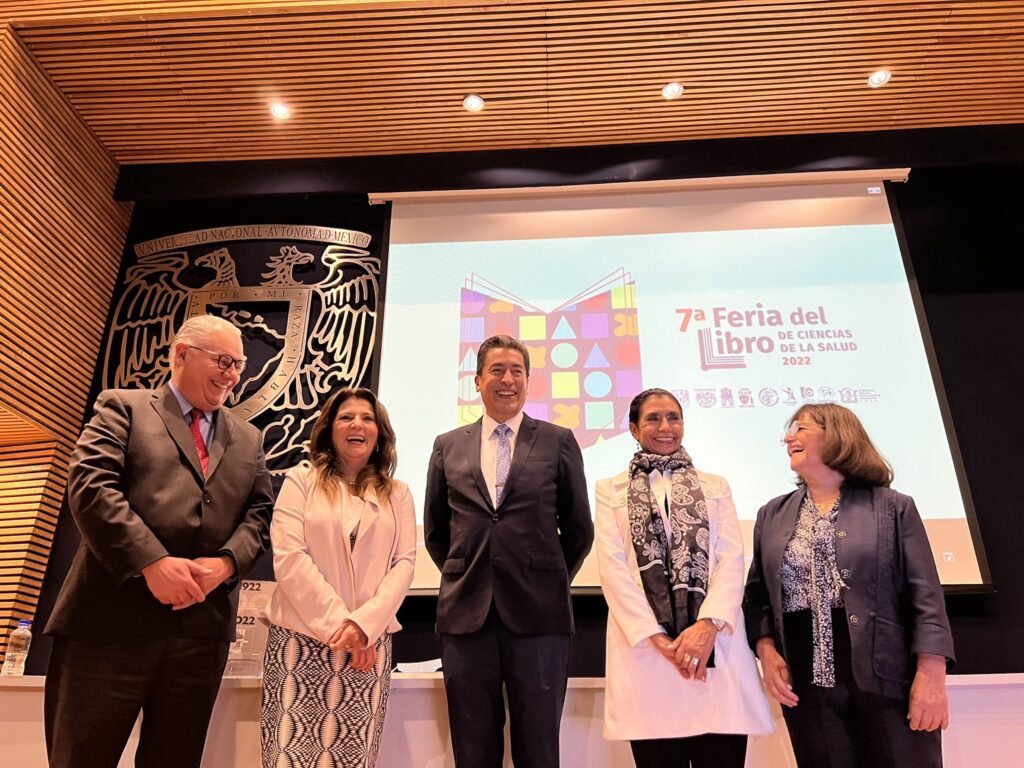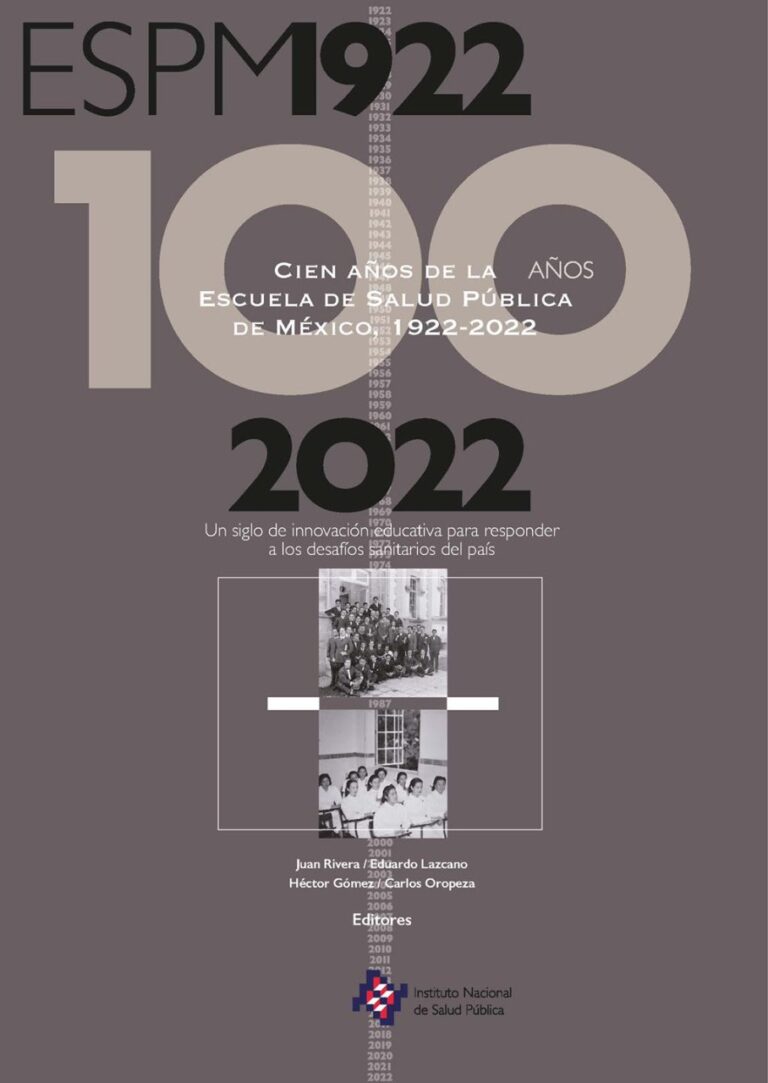Newly released book by INSP/ESPM recounts “One hundred years of the School of Public Health of Mexico, 1922-2022”

As part of the School of Public Health of Mexico’s Centennial celebration, last Friday, August 26, Dr. Eduardo Lazcano Ponce, INSP General Director, joined by some distinguished guests, presented the book “One hundred years of the School of Public Health of Mexico (ESPM), 1922-2022. A century of educational innovation to respond to the country’s health challenges”.
The work, which was edited by Dr. Juan Rivera Dommarco, former INSP General Director (2017-2022), Dr. Héctor Gómez Dantes, from the Center for Research in Health Systems; Dr. Carlos Oropeza Abúndez, INSP Deputy Director of Scientific Communication and Publications; and Dr. Eduardo Lazcano Ponce, INSP General Director; it is a professional description of the school’s history.
The presentation was made as part of the 7th School of Medicine Book Fair of the National Autonomous University of Mexico (UNAM) at the Palace of the School of Medicine in the Historic Center of Mexico City.
To commentate this work, Dr. Lazcano invited Dr. Oliva López Arellano, Mexico City’s Minister of Health, who reflected on the history of Mexico and the school itself: “The name of our school has changed in response to the popular conceptions of each era — School of Health; School of Health and Hygiene; School and Institute of Health and Tropical Diseases; School of Public Health; School of Health and Assistance, again School of Public Health and finally –and fortunately- School of Public Health of Mexico. Today its story is condensed in this book for which I have been given the privilege of offering commentary. I celebrate its publication and congratulate the editors, authors and the community of public-health workers who, with their daily work and their commitment to the population, have given life to the story narrated in detail in this endearing work”, Dr. López Arellano said.
Dr. Laura Magaña Valladares, ESPM former Director and current President of the Association of Schools and Programs of Public Health (ASPPH) in the United States, joined in the commemoration. She said, “The book rightly mentions the 1915 Welch-Rose’s report, which marks the beginning of public health professionals training in various fields required for that historical moment, such as community health officers and expert technicians in sanitary engineering, chemistry, bacteriology and epidemiology. The first step was to design a campus to promote teaching in public health and to differentiate curative from preventive medicine as John Hopkins University did with the School of Hygiene and Public Health in 1914.
ESPM has been a dynamic institution and since its foundation it has run in unison with national development. Many countries in Latin America and the Caribbean have seen ESPM as the best possibility for their academic training and have successfully returned to their countries to participate in the modernization of its health systems. This is how the school, since its creation, has accompanied the country’s historical processes from the health revolution to the epidemiological transition.
Since 1943 there have been memorandums of understanding and student exchanges, which have been intensifying over time. Among those collaborators are the Ministry of Health of Chile, the National Institute of Health of Peru, the School of Public Health of Cuba, and related health institutions such as the Rollins School of Public Health at Emory University, Harvard School of Public Health, Johns Hopkins University, the School of Higher Studies in Public Health of France, and many others. ESPM trains leaders and important actors in public health in the region of the Americas. These historical references tell us that from the beginning it was an important international actor contributing in a notable way to the strengthening of public health education not only in our country but also in Latin America and globally. This is a moment of recognition for the entire ESPM community and for the INSP for the tireless work they do every day and that is reflected in this book,” concluded Magaña.
For his part, Dr. Guillermo Fajardo, UNAM Medical School’s Director and host of the event, highlighted the history and importance of the Dr. Gustavo Baz Prada auditorium, in the Palace of Medicine, the former headquarters of the Holy Inquisition from 1736 until the end of its operation in 1820 one year before of Mexico’s independence. After three decades of abandonment, the School of Medicine was established there in1854.
“It is not by chance that we are here today talking about Public Health. Here, where there was torture, where there was death, where there was darkness during the Inquisition, it is no coincidence that today we have events like this one that summons us, where we have the opposite: freedom, education, research, where we have light because science brings light to this enclosure,” said Fajardo. He concluded by congratulating the INSP / ESPM community for 100 years of work for the country.
The last guest commentator was the historian Ana María Carrillo, who carried out her research for this book in the Ministry of Health Historical Archive, in the National Institute of Anthropology and History photo library, in the Bustamante-Vasconcelos Cultural Foundation, in the Rockefeller Archive Center and of course, at INSP library itself, all in the midst of the COVID-19 pandemic. Her speech centered on an historical overview of the role of the ESPM in Mexico, from the post-revolutionary stage, the doctors’ training during the Second World War, and the School’s support during the creation of the Mexican Institute of Social Security (IMSS), the Institute of Security and Social Services for State Workers (ISSSTE) and up to the present, as well as the role of woman and their increasingly numerous presence in the institution.
“I don’t think this is the school’s definitive history, many things have remained in the pipeline and a new century has begun. Hopefully its story can continue to be told by us and by others, and that ESPM contributes to Mexicans having health in the sense that the original Latin American people understand it, not only as the absence of disease but as that ‘walking well through life’” he said.
A heavy rain befell the Palace of Medicine during the presentation, to bear witness to the commemorative work that recognizes the great institutional achievements of a whole century, as well as the needs for innovation facing the beginning of the next hundred years of our history.
